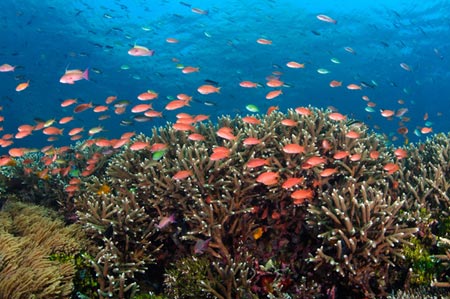The coral triangle is in danger of disappearing
Climate change can erase the world's largest biodiversity-rich marine area called the Coral Triangle located mainly in Southeast Asia at the end of the 21st century, according to a warning from the International Fund for Nature Protection (WWF).

About three-quarters of the species on the planet live in the Coral Triangle.Photo: CNN.
The coral triangle stretches from Indonesia, Philippines, Malaysia, Papua New Ghine, Solomon Islands to East Timo with an area of 5.4 million square kilometers. This sea makes up more than half of the world's coral reefs and is home to more than 3,000 species of fish. If animals and plants are included, the Coral Triangle possesses up to 75% of the species that humans once knew. Because of this high level of biodiversity, many scientists call it the "Amazon forest under the ocean".
In a new report published, WWF is concerned that the rise of ocean surface temperature, sea level and acidity threatens the existence of the Coral Triangle in Southeast Asia. The collapse of coral reefs will cause the region's seafood volume to drop by 80%, negatively impacting the lives of more than 100 million people.
'If nothing is done to combat global warming, tens of millions of people living near the coast will lose their homes due to rising sea levels. We will also face a serious food shortage. Humans will witness a real nightmare at the end of the 21st century , "said Ove Hoegh-Guldberg, one of the authors of the report.
Lida Pet Soede, director of WWF's Coral Triangle Conservation Program, stressed that the Coral Triangle is home to the most marine animals in the world. 'Some areas of the Coral Triangle play a really important role for all fish species. For example, tuna and sea turtles lay eggs here. If this sea disappears, they will not be able to produce the next generation , 'she explained.
In order to save the Coral Triangle, countries will have to commit to drastically reducing greenhouse gas emissions. Carbon emissions are likened to invisible glass panels because they do not allow heat to escape the earth's atmosphere. They are emitted from burning fossil fuels (such as coal, oil and gas). Carbon emissions are the culprits that increase the temperature of the earth, causing weather disturbance, increasing the acidity of seawater.
According to WWF, the Coral Triangle will avoid destruction if carbon emissions are cut to 80% from 1990. In addition, governments and communities will have to prevent catching. Seafood indiscriminately and polluting the sea.
'If humans continue to over-exploit resources, we will face a tremendous risk even if carbon emissions are significantly cut , ' said Richard Leck, a climate expert. WWF said.
The WWF report comes as officials from more than 70 countries will visit Manado, Indonesia, to attend the World Ocean forum next September. This is the first global conference to discuss the relationship between oceans and climate change.
- WWF initiated the Coral Triangle Day 9/6
- Why are coral reefs in the world disappearing?
- US-Indonesia protects coral triangle biodiversity
- New explanation for boats disappearing in the Bermuda triangle
- Strange creatures under the seabed of Indonesia
- 50% of corals worldwide have disappeared
- The real solution for
- The area of global coral is shrinking too fast
- Bermuda Triangle Triangle, where the truth is buried
- Visit the mysterious
- Secretly reveal the Bermuda Triangle Triangle
- Mysterious places like Bermuda Triangle Triangle
 Is the magnetic North Pole shift dangerous to humanity?
Is the magnetic North Pole shift dangerous to humanity? Washington legalizes the recycling of human bodies into fertilizer
Washington legalizes the recycling of human bodies into fertilizer Lightning stone - the mysterious guest
Lightning stone - the mysterious guest Stunned by the mysterious sunset, strange appearance
Stunned by the mysterious sunset, strange appearance